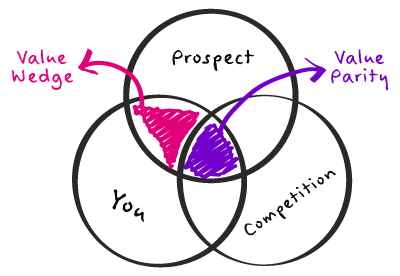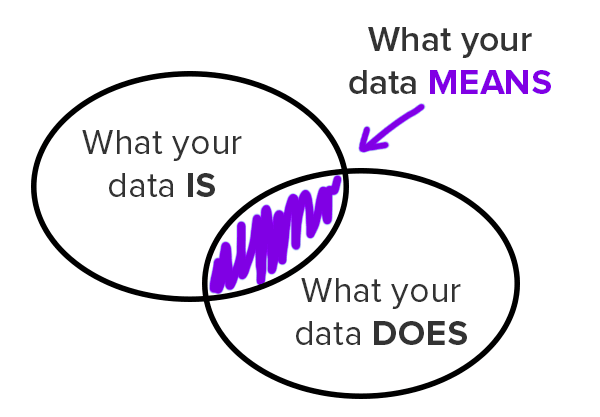
The Value Wedge: What Data IS, DOES, and MEANS in Data Governance and Data Quality Initiatives

If you’ve followed the enterprise software industry over the past ten years, you’ve probably picked up on a key trend that has led successful vendors to prominence and others to their demise – making data “fit for purpose.” The successful vendors have offered solutions that are simple to deploy, easily accessible for IT to manage and administer, while empowering its line of business users to leverage data to fully benefit their unique departmental goals.
You may be asking what I’m getting at or how this relates to the Data Governance, Lineage, and Data Quality, and I don’t blame you for struggling to connect the dots. I do, however, have a very good answer for you, and I’d invite you to join me for the next 820 or so words to find out.
Survey says….
We recently polled customers and asked them to identify which type of organizational user is most interested in accessing data lineage and data quality indicators, and got a somewhat surprising result.
“Business users,” followed closely by the “Reporting and Analytics” team, topped the vote totals. This wasn’t a complete shock, as we’ve witnessed data ownership and usage shift toward the business. However, the “technical users” group came in next to last.
This is a very interesting result when you consider that the data flows directly into critical enterprise applications, and often undergoes transformations (ETL), that these IT users are directly involved with. And, up until recently, the clear majority of data access and management was an assumed, and sometimes greatly protected, responsibility of this group of users.
So, what’s going on?
Read our white paper
Overcome Business Compliance Challenges with Better Data Quality and Data Governance
Looking ahead, it’s safe to say regulatory compliance will only bring more changes and widen its reach. See how the intersection of data quality and data governance can help you overcome compliance challenges.
Defining your organization’s competitive differentiation
When I saw the results, I was reminded of a sales strategy workshop I took a couple of years ago with the sales and presentation strategy consulting firm, Corporate Visions. The firm helps companies define their “value wedge”, or competitive differentiation, in efforts to allow organizations to compete more successfully, based on the “IS,” “DOES” and “MEANS” of your product.

An example of this strategy can be easily explored and outlined by looking at your very own smart phone device. If I asked you what is the smart phone made of, you might respond, plastic, circuit boards, a camera, speaker, screen, and buttons. If I asked you what the phone does, you might say that it stores the information of your friends and family, it makes phone calls, takes pictures, lets you surf the internet, play games and helps you with math from time to time. But what does the smart device mean to you?
It means that you can video chat with your kids when you are halfway around the world. It means that you can run your small business on a beach vacation, or connect with old high school buddies on social media. It means you can capture memories that will stay with you forever. This is where understanding what the product means helps sell the product.
I can’t help but feel that the value wedge strategy also holds true when we look at how organizations manage and interact with their own organizational data. I believe we are seeing the clear differentiation of two core groups within every organization that are equally important in a successful approach to any data critical initiative.
- Technical users excel in understanding what data IS, the coding and integration, the 0s and 1s, managing and provision of infrastructure, as well as how specific data supports mission critical organizational applications. (Amongst countless other strategic tasks, often thankless).
- Business users understand what that specific data DOES, and excel in using the data made available to them within applications. Not only at an organization macro level, but how it directly impacts their critic departmental processes and performance.
What your data MEANS: uncovering the value wedge
A 1994 episode of Seinfeld, “The Gymnast,” features a Magic Eye stereogram, much like the image below. Elaine’s boss finds himself staring at the image for hours each day trying to make out a hidden spaceship, seeing beyond the color and patterns, while Kramer easily makes out the real image in vivid detail.

I can’t help but think of how powerful of an analogy that can be in many circumstances when a person who excels in understanding what data IS, stands near a person who excels in the DOES. This IS person clearly sees the many colors, shapes, patterns, and borders of the picture, while the DOES person can make out a vivid real image (I’m an IS person, so I couldn’t tell you whether the picture above is a spaceship or dinosaur).
I firmly believe that there is, and will always, be a striking difference in how data is viewed and understood, and that is what makes both perspectives so valuable for organizations. You need both perspectives to be successful. However, it isn’t until those two perspectives combine that an organization truly understands what the data MEANS…

So, what does your data MEAN to your organization? For compliance and regulation reporting? What does it mean for your bottom line? For efficiency and productivity? What would having confidence in your enterprise data today mean to you?…
See how the intersection of data quality and data governance can help you overcome compliance challenges. Read our eBook: Overcome Business Compliance Challenges with Better Data Quality and Data Governance


